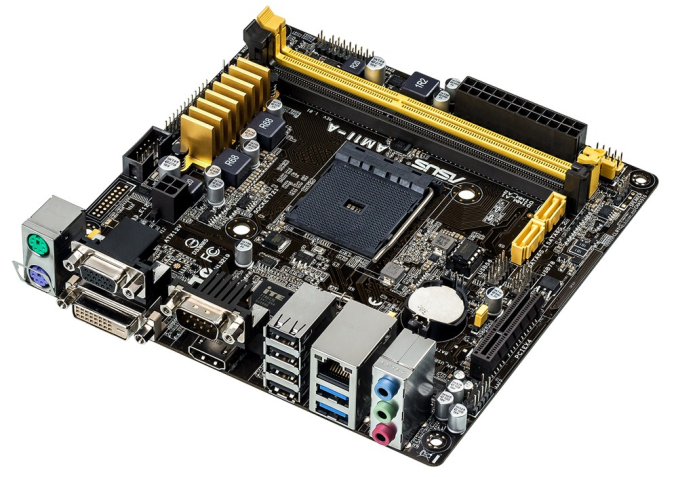The AM1 Kabini Motherboard Preview: Analyzing the Hardware
by Ian Cutress on April 19, 2014 2:00 PM ESTASUS AM1I-A
The more expensive ASUS Kabini motherboard comes in a smaller form factor and mirrors a lot of the functionality of the bigger sibling. We still have the trio of LPT/TPM/COM headers on the motherboard, although for the AM1I-A another COM port is on the rear panel. There is no extra USB 3.0 controller here, but the DRAM slots use a single latch system and the PCIe 2.0 slot is a true open-ended x4.
Both fan headers are 4-pin, and we again have a Realtek network/audio combination featuring the ALC887 codec for the audio. ASUS has interestingly chosen to place the TPM outside the DRAM slots rather than the SATA ports, with the latter ending up just to the left of the DRAM and above the PCIe slot. Somewhat confusingly while there is a diagram showing the front panel connectors, it ends up being a good inch away from where the front panel actually is.
With this $50 motherboard ASUS offers both PS/2 ports and a full array of four USB 2.0 ports on the back panel. Three video outputs are given (VGA, DVI-D and HDMI), along with the two USB 3.0 ports from the chipset. We get the Realtek ALC887 audio jacks as well.
| ASUS AM1I-A | |
| Price | Link |
| Size | Mini-ITX |
| CPU Interface | FS1b |
| Chipset | Kabini |
| Memory Slots |
Two DDR3-DRAM slots, suporting 32GB Single Channel, 1066-1600 MHz |
| Video Outputs |
VGA (2046x1536 at 60Hz) DVI-D (1920x1200 at 60 Hz) HDMI (4096x2160 at 24 Hz or 1920x1080 at 60 Hz) |
| Onboard LAN | Realtek 8111GR (10/100/1000) |
| Onboard Audio | Realtek ALC887 |
| Expansion Slots | PCIe 2.0 x4 |
| Onboard SATA/RAID | 2 x SATA 6 Gbps |
| USB 3.0 | 2 x USB 3.0 (Chipset) [back panel] |
| Onboard |
2 x SATA 6 Gbps 2 x USB 2.0 Headers 2 x Fan Headers TPM Header LPT Header COM Header Front Audio Header Front Panel Header |
| Power Connectors |
1 x 24-pin ATX 1 x 4-pin CPU |
| Fan Headers |
1 x CPU (4-pin) 1 x CHA (4-pin) |
| IO Panel |
1 x PS/2 Mouse Port 1 x PS/2 Keyboard Port VGA DVI-D HDMI 1 x Gigabit Ethernet 2 x USB 3.0 Ports 4 x USB 2.0 Ports 1 x COM Port Audio Jacks (ALC887) |
| Product Page | Link |
Users may notice that this is the first Kabini motherboard in our line up with a heatsink over the power delivery. This may aid users in warmer climates to prevent the CPU throttling under stress.













64 Comments
View All Comments
JFish222 - Monday, April 21, 2014 - link
I agree, its disappointing that there is no ECC. (At least not listed.)I was really looking forward to using one of these for a low cost FreeNAS box.
Ian, Anand and company. Please encourage ECC bios support/validation! If any of the manufacturers support it (not always obvious when they do) please point it out.
For those that don't understand the importance, ZFS has numerous benefits but its greatest weakness is the ability to corrupt the entire data pool due to a flipped bit or 2 in RAM.
For more info - http://forums.freenas.org/index.php?threads/ecc-vs...
Chicken76 - Monday, April 21, 2014 - link
Indeed, Anandtech has the ear of motherboard manufacturers. They might respond positively if such suggestions are properly argumented. There's not only the enthusiast home user that these might be useful to, there's also the small businesses sector, where cost is a deciding factor. Add ECC support and a bit of validation for production use, and a lot of the cost-conscientious businesses will refresh their storage boxes and low workload machines using Kabini, instead of the Pentiums and Celerons they use now.rogueninja - Sunday, April 20, 2014 - link
Only bad friends recommend AMD.meacupla - Sunday, April 20, 2014 - link
Currently, AMD's most attractive CPU parts are the $60 A6-6400k and $120 FX-6300.Pentium and i3 have more single thread computing power, but looking at the entire package, AMD has some advantages at those price points.
Like a cheap 8 port SATA mobo, you can't have that with cheap LGA1150 boards.
or having 6 physical cores.
Antronman - Monday, April 21, 2014 - link
Except that when you're on a low budget, AMD is the only thing you should be recommending.Ortanon - Tuesday, April 22, 2014 - link
Intel usually wins low-budget too, haha. If you're talking "best gaming performance at the absolute bottom," yes, AMD wins. But who wants to game down there? As soon as you try to add any performance to your build whatsoever, it turns into an Intel solution with a PCIe GPU. It's possible that this would be different if all software was highly-threaded, but it just doesn't work out that way.AlB80 - Sunday, April 20, 2014 - link
Gigabyte's mobo has heatsink. What behind it? SuperIO?DuckieHo - Monday, April 21, 2014 - link
Biostar's mITX-Plus..... isn't that just AMD's DTX form factor?JBVertexx - Monday, April 21, 2014 - link
Stumbled across this - PC build in the motherboard box:https://www.youtube.com/watch?v=xngzjrKg3zI
WeatherDave - Monday, April 21, 2014 - link
"COM port, LPT port and a TPM port on the same PCB"We have about 50 machines here. Mostly for embedded testing, such as stepper motors, and old equipment that ONLY connects via Serial Port. USB converters are both unreliable and prone to failure, so we like having the COM ports on board. Besides, Windows 98/2000 and XP much prefer them over a converter. Now, we don't have much use for the LPT, but TPM and a cheap SSD certainly keeps IT Security off our backs.